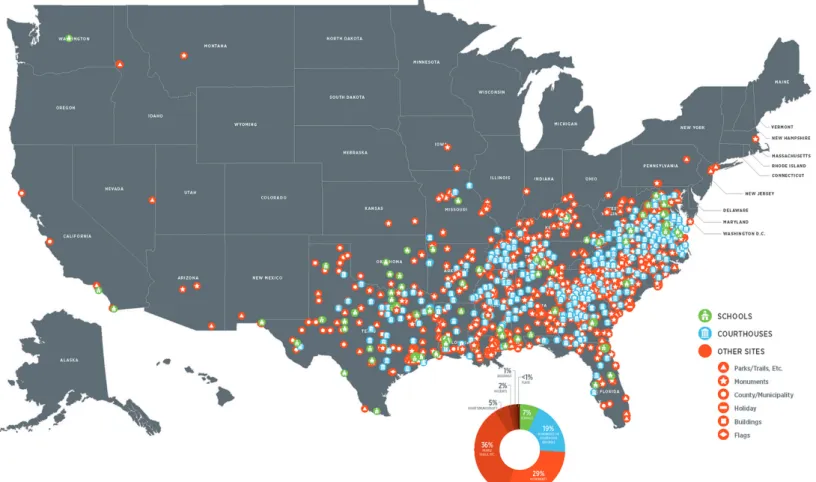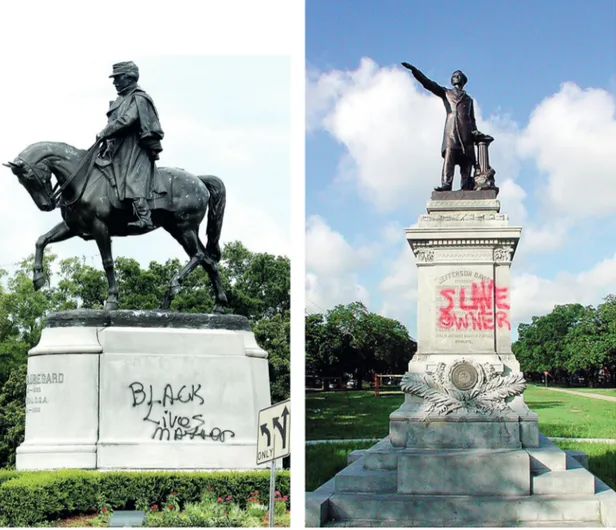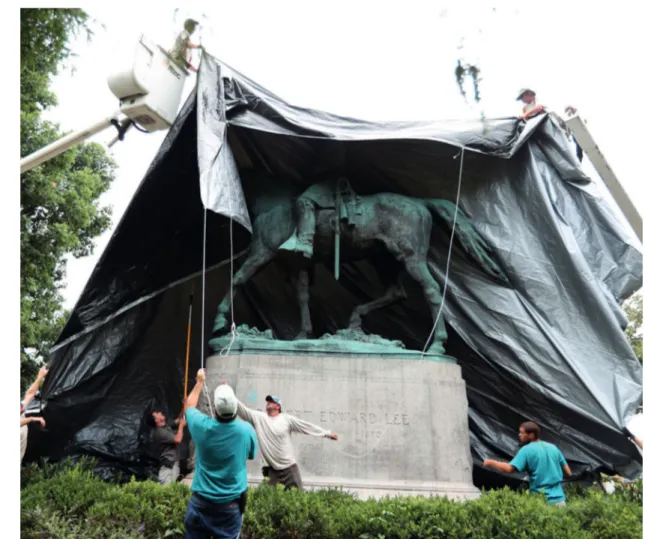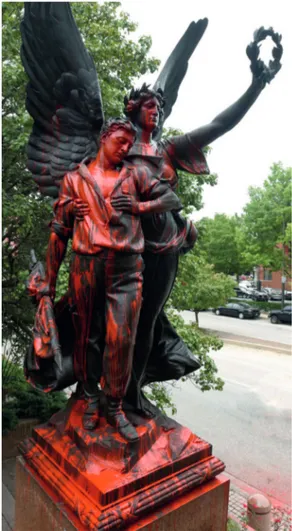Il mutato lutto della Guerra di Secessione: l’apertura dei memoriali a
nuovi significati
Confederate War Grief Transformed: the Openness of Memorials to
New Meanings
Phoebe Crisman Phoebe Crisman AIA is Associate Professor of Architecture at the University of Virginia, USA, where she directs the Global Environments + Sustainability program. Her recent publications include chapters in Transgression: Towards an Expanded Field of Architecture, Peripheries, The Hand & the Soul, and Agency. Educated at Harvard and Carnegie Mellon Universities, she practices with Crisman+Petrus Architects.
Keywords: social memory, memorialization, war memorials, US civil war, slavery
I memoriali della Guerra Civile negli Stati Uniti rappresentano la complessa memoria nazionale di una guerra intestina, tutt’ora contestata, su questioni di schiavitù, equità sociale e valori pubblici. Oggi si assiste a un acceso dibattito sui monumenti che onorano i comandanti e i soldati confederati. Per molti, la memoria sociale originale è scomparsa e i significati ad essi attribuiti si sono spostati dalla relazione con i caduti di guerra, o dal culto della “causa persa”, a simboli di schiavitù e di supremazia bianca. Le loro forme sono aperte a nuove interpretazioni legate alla soggettività umana e alla loro localizzazione. Questi memoriali glorificano il razzismo o assorbono la memoria storica del lutto? Questo articolo esamina il dibattito in corso sui memoriali della Guerra di Secessione, come prova del ruolo
potente dei monumenti nella città e del loro mutevole significato. Parole chiave: memoria sociale, commemorazione, memoriali di guerra, Guerra Civile Americana, schiavitù Civil War memorials in the United States represent the
difficult national memory of a still contested internecine war over slavery, social equity, and public values. Today there is a heated debate about physical monuments honoring Confederate leaders and soldiers. For many, the original social memory has disappeared and meanings attributed to them have shifted from association with war dead, or the cult of the “lost cause,” to symbols of slavery and white supremacy. Their forms are open to new interpretations connected to human subjectivity and situatedness. Do these confederate memorials glorify racism or absorb the historical memory of grief? This paper examines the ongoing Confederate war memorial debate as evidence of the powerful role of monuments in the city and their changing meaning.
110
Physical memorials erected to commemorate grief wrought by war are prominent in contemporary cities around the world. The ongoing debate about Confederate memorials in the United States is evidence of the powerful role of monuments in the city and their ever-changing meaning. These memorials represent the difficult national memory of a still contested internecine war over slavery, social equity, and public values (fig. 1). For many, the original social memory has disappeared and meanings attributed to them have shifted from association with war dead, or the cult of the “lost cause,” to symbols of slavery and white supremacy. Their forms are open to new interpretations that are dependent on human subjectivity and situatedness. Do these confederate memorials glorify racism or absorb the historical memory of grief?
In the United States over seven hundred public monuments and 1500 public symbols honor the Confederate side of the American Civil War that raged between 1861 and 1865.1 (fig. 2) The war was fought
over the Confederate or Southern States’ rights to perpetuate slavery. The Northern States fought to end slavery and preserve the Union. After 750,00 soldiers were killed2 and more than one million were wounded,
the North was victorious, slavery was abolished, and over four million slaves were freed. As noted by historian David Blight, “The most immediate legacy of the war was its slaughter and how to remember it. Death on such a scale demanded meaning.”3
For instance, the American national holiday of remembrance, Memorial Day, began immediately after the Civil War as Decoration Day. Over time the history of the losing Confederate side was rewritten and collective public remembrance was embodied in physical memorials erected mostly in Southern cities
111
fig. 2 Location of Confederate Symbols in the United States (Southern Poverty Law Center, Whose Heritage? Public Symbols of the Confederacy, 2016, pp. 14-15)
112
Let’s briefly consider the role of the memorial. Building on geographer Yi-Fu Tuan’s study of how we use artifacts to give fleeting experience “a semblance of duration and coherence,”4 historian James Mayo
has defined the memorial as “an artifact that imposes meaning and order beyond the temporal and chaotic experiences of life.”5 Memorials may reference tragic
or non-tragic events.6 Aside from individual death
markers; war memorials are the earliest and most common memorials in the United States. Because of their politicized nature, depicting winners or losers at a moment in history, war memorials are particularly controversial and may be read in contradictory ways over time. This essay examines how physical memorials initially establish meaning, and how these physical objects are appropriated and invested with new meanings over time. How does this process work and for whom do these monuments speak?
In “War Memorials as Political Memory,” Mayo has noted “Remembrance of the past by communities cannot be separated from the ongoing values that they wish to embrace, but how are their ideals related to the past and the present?... Do war memorials provide sanctuaries from the present by idealizing the past through commemoration?”7 Geographer
David Lowenthal has studied how communities often escape an undesirable present by idealizing the past.8 This tendency is particularly common in times
of turmoil and rapid change. Demographics in the United States are shifting away from a largely white and Christian population to a more diverse one. The loss of manufacturing jobs and other socio-economic changes are challenging for many. The nation has been radically transformed in the 152 years since the end of the Civil War.
Because of these changes, Americans’ understanding of the past and their interpretations of Civil War
memorials have changed as well. As examined by Mayo, “When people accept these changes, they reinterpret the dedicated meanings for memorials to past wars. If the new interpretations are contradictory, the memorials are eventually seen as having conflicting meanings.”9 This state of conflicting
meanings is responsible for the heated debate and violent actions currently unfolding across the country. Human subjectivity and individual situatedness play a large role in these differing interpretations.
“Personal bias affects the perception of what actual history is and what should be remembered and commemorated. War memorials unavoidably present multiple messages, because a range of clientele interprets history differently… When individuals lack knowledge or disagree about actual history, the past is difficult to commemorate. They may sincerely desire to remember past wars, but their assumptions and understanding of history can render commemoration unauthentic.”10
For instance, many current protectors of Confederate monuments ignore significant historical facts, including the role of slavery in the Civil War. They are apparently unaware of documents, such as the Cornerstone Speech delivered by Confederate Vice President Alexander Stephens on March 21, 1861, which explained the foundations of the new Confederate government. This speech clearly stated the perpetuation of slavery as the ‘cornerstone” and hence a central reason for Confederate succession from the Union.
“Our new government is founded upon exactly [this] idea; its foundations are laid, its corner-stone rests upon the great truth, that the negro is not equal to the white man; that slavery — subordination to the superior race — is his natural and normal condition. This, our new government, is the first, in the history
of the world, based upon this great physical, philosophical, and moral truth.”11
Along with intentions, it is crucial to understand when these monuments were erected and by whom. This timeline created by the Southern Poverty Law Center (fig. 3) shows two major periods when the majority of Confederate monuments were built — during the first two decades of the twentieth century when Jim Crow laws were enacted that re-established racial segregation and as the Ku Klux Klan gained popularity, and throughout the late 1950s and 1960s civil rights movement. These two periods also coincided with the fiftieth anniversary and centennial of the Civil War.12
Along with their social and commemorative function, however, monuments are used to create beauty and express power in public spaces. Most Civil War monuments were erected during the City Beautiful movement — a period from the 1890s to the 1920s — when prosperous Americans sought to beautify and monumentalized their cities.13 The World’s Columbian
Exposition of 1893 manifested this tendency on a large scale, while towns and cities across the United States created civic monuments, parks and major public buildings to add grandeur to the public realm. Unlike other parts of the country, however, in the American south this narrative was coupled with a glorification of the Confederate past. For instance, Monument Avenue in Richmond (1890), Lee Circle in New Orleans (1884), and Lee Park in Charlottesville (1924) were built at this time (fig. 4). These monuments are located at the center of important urban spaces, near courthouses, libraries and city halls. They demarcate these spaces as centers of white power and privilege, sending a message of authority and control that excluded black citizens. What do these confederate memorials commemorate today… the grief of lost lives, a lost war, a lost way of life? Do they represent violence,
113
fig. 3 Timeline of Confederate Iconography in the United States (Southern Poverty Law Center, Whose Heritage? Public Symbols of the Confederacy, 2016, pp. 12-13)
114
fig. 4 Postcard of Monument Avenue and Lee Monument, Richmond, Virginia (Richmond News Company)
115
death, courage, fortitude, or sorrow? Can they still absorb the historical memory of war grief or do they merely glorify racism? Whatever the response, Civil War memorials today certainly represent the difficult national memory of a still contested internecine war over slavery, social equity, and public values.
Racial tensions are particularly high in the United States this year, due to current political leadership, heightened awareness of racial injustice due to the effective ‘black lives matter’ campaign, and a series of horrific events. Instant communication provided by the Internet, which facilitates extremist online communities, has contributed as well. All these events have spurred a heated debate about monuments honoring Civil War soldiers and leaders. This issue has become a locus for political protest and physical transformations across the South. Many cities, such as New Orleans, St. Louis, and Baltimore have removed Confederate monuments. Amidst politically charged protest, for instance, four major urban monuments were removed in New Orleans in June 2017. They honored confederate heroes or causes, including General Robert E. Lee and General P.G.T. Beauregard— whose statue was spray painted with the words “black lives matter,” and Confederate President Jefferson Davis’ statute marked with the words “slave owner” (fig. 5). New Orleans Mayor Mitchell Landrieu explained the removals in this way:
“These statues are not just stone and metal. They are not just innocent remembrances of a benign history. These monuments purposefully celebrate a fictional, sanitized Confederacy; ignoring the death, ignoring the enslavement, and the terror that it actually stood for. After the Civil War, these statues were a part of that terrorism as much as a burning cross on someone’s lawn; they were erected purposefully to send a strong message to all who walked in their shadows about
fig. 5 General P.G.T. Beauregard statue spray-painted with “Black Lives Matter” slogan on June 28, 2017 (Eliot Kamenitz/The New Orleans Advocate/Associated Press); Confederate President Jefferson Davis statue spray-painted “Slave Owner,” New Orleans (Wikimedia Commons)
116
who was still in charge in this city.”14
The New Orleans Monumental Task Committee, which maintains monuments and plaques in the city, criticized the removal of the memorials from a historical position. “Mayor Landrieu and the City Council have stripped New Orleans of nationally recognized historic landmarks… With the removal of four of our century-plus aged landmarks, at 299 years old, New Orleans now heads in to our Tricentennial more divided and less historic.”15 Are these removals
a long overdue iconoclasm, a misguided attempt to erase history, or an effective way to reduce the grief of descendants of enslaved peoples?
A battle is raging over the fate of two prominent civil war memorials in the small University town of Charlottesville, Virginia. Both equestrian statues were erected in newly created public squares on gentrified land in the early 1920s. Located adjacent to the Albemarle County Courthouse in Court Square, the statue of Confederate General Stonewall Jackson was dedicated in 1921 during a reunion of the Confederate Veterans and the Daughters of the Confederacy. The statue of Confederate General Robert E. Lee was unveiled in Lee Square three years later during a gathering of the Sons of the Confederacy.16 Both
statues were centrally positioned to memorialize the Confederacy and monumentalize the Lost Cause. Amidst heightened racial tensions in the US and after several months of heated debate, the Charlottesville City Council voted to remove the statues in April 2017.17 The debate in Charlottesville elicited diverse
reactions, ranging from respect and possessiveness, as in “Hands off our monuments” (fig. 6) and “Confederate History Matters”, to angry rejection of the monuments (fig. 7). Others considered the role of the monuments in evoking memory — “You cannot change history, but you can learn from it.” While
a lawsuit has temporarily stopped their removal, Lee Park, the central square dominated by the Lee Statue, was renamed Emancipation Park two months later. These actions sought to reconcile the history of slavery and racial inequality. These decisions also drew the attention of a range of Confederate apologist and white supremacist groups. In August, white nationalists organized a Unite the Right Rally in Charlottesville to protest the planned removal of the statues, which they associated with the threat of white “rights’ and their own values. They marched and chanted the slogan, “You will not replace us.”18 The
violence and death that ensued, with one resident killed and many injured, spurred a rapid response by politicians, the press, and citizens on both sides of the issue.
Many cities decided to remove Confederate memorials immediately after the dramatic violence in Charlottesville. For instance, two days after the Charlottesville protests, a Civil War Soldier statue was literally pulled down and smashed by an angry mob in Durham, South Carolina (fig. 8).19 Two days
later, the Baltimore City Council voted unanimously to remove all Confederate statues that night under cover of darkness. Four statues were quickly removed, including a Confederate Women’s Monument. The mayor explained the decision: “For me, the statues represented pain, and not only did I want to protect my city from any more of that pain, I also wanted to protect my city from any of the violence that was occurring around the nation.”20 The city of
Charlottesville, unable to remove the memorials due to a court injunction, shrouded both in black (fig. 9). Clearly, these urban memorials have incited intense passions because they are open to a wide range of interpretations (fig. 10). For some they still memorialize the Civil War dead, to others they legitimize the
southern cult of the “lost cause,” and to others they are symbols of slavery and white supremacy. Most of these statues memorialize confederate soldiers in general — “the boys in gray”, rather than referring to specific military or political leaders. Yet, protesters see these anonymous figures as embodiments of evil as well. Of course, the problem of controversial public memorials is not unique to these Confederate statutes. Countries around the globe are dealing with the physical reminders of fallen regimes, past ignominious leaders, and dishonorable actions.21
As Americans re-evaluate our racial history amidst the current climate of social, economic, and racial divisions, the original meanings attributed to these memorials must be re-evaluated as well. As a nation, we are coming to terms with both the myths and realities that have been established and embodied in these Confederate memorials. Amidst a growing focus on the digital and the virtual, this ongoing and very public Civil War memorial debate is further evidence of the powerful role of monuments in the contemporary city.
Notes:
1.Southern Poverty Law Center, Whose Heritage? Public
Symbols of the Confederacy, Montgomery, Alabama, 2016, p.
8
2.Guy Guggliotta, “New Estimate Raises Civil War Death Toll” in The New York Times, April 12, 2012
3.David Blight, Race and Reunion: The Civil War in American
Memory, Harvard University Press, Cambridge, 2001, p. 64.
Also see John Bodnar, Remaking America: Public Memory,
Commemoration, and Patriotism in the Twentieth Century,
Princeton University Press, Princeton, 1992
4. Yi-Fu Tuan, “The Significance of the Artifact” in Geographical
117 fig. 6 Residents with “Hands off our monuments” signs protesting planned removal of Robert E. Lee monument, Charlottesville, Virginia, 2017 (WVTF)
fig. 7 Resident with “Fuck Yo Statue” sign at Robert E. Lee statue removal Rally, July, 8, 2017, Charlottesville, Virginia (photographer unknown)
118
fig. 8 Durham, South Carolina, 2017 (Reuters) fig. 9 Shrouding of the General Robert E. Lee statue, Charlottesville,
119 5.James Mayo, “War Memorials as Political Memory” in
Geographical Review, January 1988, 78(1), p. 62
6.Kenneth E. Foote, Shadowed Ground: America’s Landscapes
of Violence and Tragedy, The University of Texas Press, Austin,
1997 7.Mayo, p. 70
8.David Lowenthal, The Past is a Foreign Country, Cambridge University Press, Cambridge, 1985; Svetlana Boym, The
Future of Nostalgia, Basic Books, New York, 2002; and Paul
Ricoeur, Memory, History, Forgetting, University of Chicago Press, Chicago, 2004
9.Mayo, p. 73 10.Mayo, p. 73
11.Thomas E. Schott, Alexander H. Stephens of Georgia: A
Biography, Louisiana State University Press, Baton Rouge
and London, 1996, p. 334
12.Southern Poverty Law Center, p. 13
13. William H. Wilson, The City Beautiful Movement, The Johns
Hopkins University Press, Baltimore, 1989; Charles Mulford Robinson, Modern Civic Art: Or, The City Made Beautiful, G.P. Putnam’s Sons, New York and London, 1903; and Peter Hall,
Cities of Tomorrow, Wiley-Blackwell, London, 2002
14. Mitch Landrieu, “Mitch Landrieu’s Speech on the Removal of Confederate Monuments in New Orleans” in The New York
Times, May 23, 2017
15. Associated Press, “In New Orleans, Confederate Monuments are Finally Gone” in New York Post, May 20, 2017 16.Sophie Abramowitz, Eva Latterner, and Gillet Rosenblith, “Tools of Displacement” in Slate, June 23, 2017
17.Megan Garber, “Why Charlottesville?” in The Atlantic, August 12, 2017
18.Jacey Fortin, “The Statue at the Center of Charlottesville’s Storm” in The New York Times, August 13, 2017; Dahlia Lithwick, “They will not Replace Us” in Slate, August 13, 2017; Benjamin Wallace-Wells, “The Fight over Virginia’s Confederate Monuments” in The New Yorker, December 4, 2017
19.David A. Graham, “Durham’s Confederate Statue Comes Down” in The Atlantic, August 15, 2017; Maggie Astor, “Protesters in Durham Topple a Confederate Monument” in
The New York Times, August 14, 2017
20.Nicholas Fandos, Richard Fausset and Alan Blinder, “Charlottesville Violence Spurs New Resistance to Confederate Symbols” in The New York Times, August 16, 2017
21.Bill Niven, “War Memorials At The Intersection Of Politics, Culture And Memory” in Journal of War & Culture Studies, 2007, 1(1),pp. 39-45; Isaac Stanley-Becker. “Rewriting History or Attending to the Past? Monuments still Confound Europe, Too” in The Washington Post, August 19, 2017
fig. 10 Confederate Soldiers and Sailors Monument, Baltimore, Maryland. Taken down on August 15, 2017(Jerry Jackson, The Baltimore Sun)





